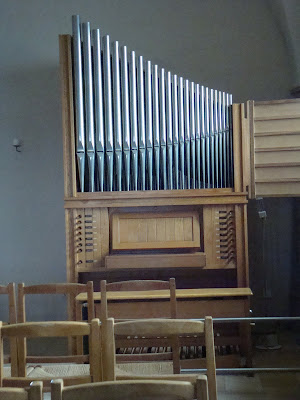 "The Wartburg: what a host of memories this name evokes for every German! Where is the castle that is its equal in historical significance and poetic solemnity?" Hugo von Ritgen
"The Wartburg: what a host of memories this name evokes for every German! Where is the castle that is its equal in historical significance and poetic solemnity?" Hugo von Ritgen In the 1850s the Bergfried was built and was furnished as a grand-ducal residence and a museum. They created a granary and a knights' bath house. Today this is a cafe and a hotel.
In the 1850s the Bergfried was built and was furnished as a grand-ducal residence and a museum. They created a granary and a knights' bath house. Today this is a cafe and a hotel.
Going Into the Castle
 Organ concerts as well as Protestant and Catholic Services are held here today. They are held in memory of Saint Elisabeth and Martin Luther.
Organ concerts as well as Protestant and Catholic Services are held here today. They are held in memory of Saint Elisabeth and Martin Luther.
 The mosaic shows scenes from the life of the saintly Elisabeth of Hungary, the most remarkable woman in the history of Wartburg.
The mosaic shows scenes from the life of the saintly Elisabeth of Hungary, the most remarkable woman in the history of Wartburg. Elisabeth Gallery
Elisabeth GalleryIn this gallery the painter, Moritz von Schwind, narrates the life of Saint Elisabeth and underlines her charitable role with the Seven Acts of Charity

Hall of Minstrels
 The legend of the contest of minstrels, portrayed here, is based on historic events.
The legend of the contest of minstrels, portrayed here, is based on historic events.Banquet Hall
 This hall received it's contemporary look in the 19th Century when the trapezoidal paneled ceiling, which gives the room a remarkable acoustic, was added. The overall appearance of the banquet hall represents the 19th century perceptions of the Middle Ages and is one of the finest ensembles of the Historicism era.
This hall received it's contemporary look in the 19th Century when the trapezoidal paneled ceiling, which gives the room a remarkable acoustic, was added. The overall appearance of the banquet hall represents the 19th century perceptions of the Middle Ages and is one of the finest ensembles of the Historicism era.In 1817 students from eleven universities met at the Wartburgfest. They commemorated the 300th anniversary of Reformation Day. In commemoration of this event, the flag of the first student fraternity in the city of Jena was hoisted on the middle chimney; its colors black-red-gold were later to become the German national flag.
For a number of decades the grand hall is has been used for concerts and numerous cultural events.
The Royal Bedroom

The Museum



Hallway to the Area of the Castle where Martin Luther wrote sermons and translated the Bible while in seclusion.

Martin Luther was placed under Imperial ban and declared an outlaw along with all those who adhered to his teachings. It was not possible for him to return to Wittenberg so a sham attack was stage-managed by a local magistrate from Gotha. Luther was taken captive to Wartburg where arrangements had been made for "prison" accommodations worthy of a gentleman, where he spent the next ten months almost exclusively.
 In order to remain incognito, Luther sprouted a beard, let his hair grow, wore worldly clothing and went by the name of "Junker Joerg".
In order to remain incognito, Luther sprouted a beard, let his hair grow, wore worldly clothing and went by the name of "Junker Joerg".



































